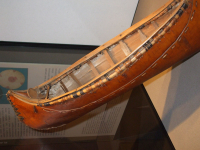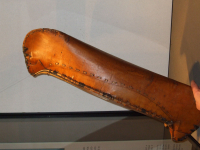canoe, model
canoe, model
canoe, model
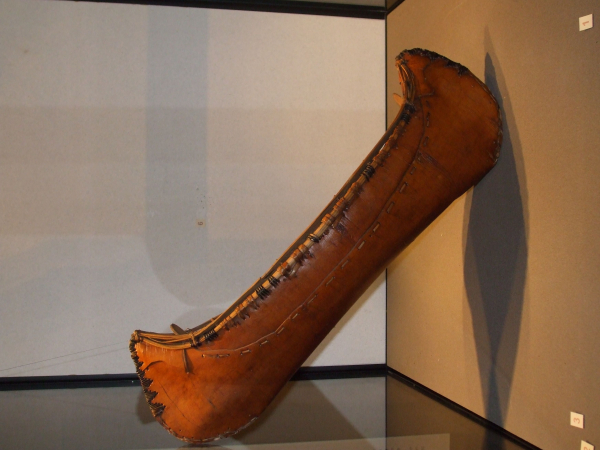
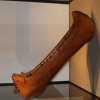
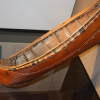

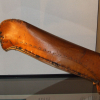
A model canoe made of birch bark and decorated with porcupine quills, with a manboard at one end. The collector, Italian explorer G. Costantino Beltrami, wrote that he had this object made in 1823 in Ft. St. Anthony (also known as Ft. Snelling), an area that was inhabited by many Ansihinaabe and Sioux. Around 1856, Beltrami's nephew donated several objects, including this one, to the Civic Library of Bergamo. Later the collection was transferred to the Museo Civico di Scienze Naturali, its current location.
Leonardo Vigorelli deduces that the "Local Group of Origin", as he writes in the Beltrami Collection''s Catalogue, is "Chippewa".
Based on museum documentation.
Read More About This Relative
birchbark; wood; split root; porcupine quills dyed red and black; vegetal fiber.
The model canoe is made of birchbark. The thwarts and ribs are made of wood splints. There is a manboard at one end. Porcupine quillwork decorates the canoe's edges and sides.
Provenance
In his travel account Beltrami wrote that he had this object made in 1823 in Ft. St. Anthony. Beltrami's collection catalogue states that around 1856, Beltrami's nephew donated several objects to the Civic Library of Bergamo, which were later transferred to the Museo Civico di Scienze Naturali.
The Beltrami Collection was exhibited in Florence in 1929 during the "Prima Esposizione Nazionale di Storia delle Scienze" (First National Exposition of History of Sciences"). In 1973, during a celebration of the Beltrami exhibit, Glauco Luchetti donated three objects from his own collection, which were located in Beltrami's last house in Filottrano, to the "Museo Civico E. Caffi". In 1987 the collection was used in the exhibit entitled "Missisippi 1823. Oggetti indiani raccolti da G. Costantino Beltrami" in the Galleria Lorenzelli in Bergamo.
Beltrami s Collection Catalogue, p. 59.
Vigorelli, Gli Oggetti indiani raccolti da G.Costantino Beltrami.
Leonardo Vigorelli, Gli Oggetti indiani raccolti da G.Costantino Beltrami, Civico Museo E. Caffi, Bergamo, 1987.
About This GRASAC Record
This record was created by Emanuela Rossi after a trip funded by GRASAC to the Museo Civico E. Caffi in Bergamo, Italy in October 2008.
Researchers present: Emanuela Rossi.
44.8933, -93.1806
In the Beltrami Collection Catalogue, the author, Leonardo Vigorelli, defines "Upper Mississippi" the Cultural Area of Origin. He defines "Northeast" as the Geographic Area. In his travel account Beltrami wrote that he had this object made in 1823 in Ft. St. Anthony. Anishinaabe and Sioux peoples lived in this area, now known as Minneapolis, Minnesota. See Tanner (1987: 147).
 Knowledge Sharing Platform
Knowledge Sharing Platform


